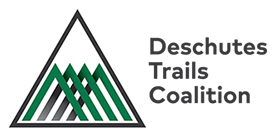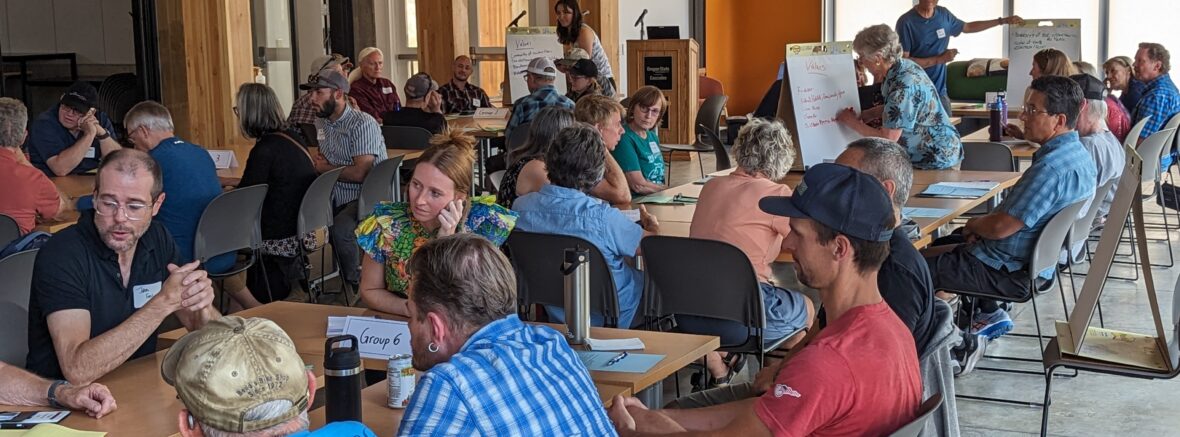The Deschutes Trails Coalition convened a facilitated, community-wide conversation to share information and gather public feedback regarding the potential use of Class 1 pedal-assist electric bicycles on soft-surface non-motorized trails on the Deschutes National Forest in Central Oregon.
Currently, the U.S. Forest Service (USFS) does not allow e-bikes on Deschutes National Forest non-motorized trails. However, e-bikes could be allowed in the future after a U.S. Forest Service (USFS) -led assessment. The following report summarizes the input collected during multiple meetings that made up the community-wide conversation led by the Deschutes Trails Coalition.
This report focuses solely on Class 1 e-bikes and their potential use on soft-surface trails within the Deschutes National Forest. This seemed like the best place to focus the conversation because Class 1 e-bikes most closely resemble traditional mountain bikes and seem to represent the class of e-bike of most interest to ride on non-motorized trails.
| Class | Pedal Assist Only? | Throttle? | Motor Stops Assistance At: |
|---|---|---|---|
| Class 1 | ✓ | 20 mph | |
| Class 2 | Motor can exclusively propel without pedaling | ✓ | 20 mph |
| Class 3 | ✓ | 28 mph |
Examples of Class 1 E-Bikes
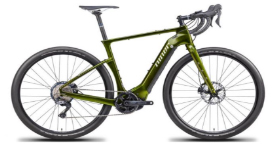

Examples of Class 2 & 3 E-Bikes
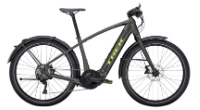
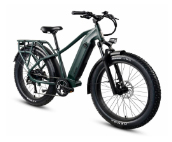
More About Class 2 & 3 E-Bikes:
- Typically, are not e-mountain bikes
- Typically, are larger and heavier than class 1 e-bikes
Identified Concerns
The following is a list of themes identified through the community conversation relating to the potential use of Class 1 e-bikes (see table 1 below for classifications) on non-motorized trails on the Deschutes National Forest.
- An increasing volume of users of all use types can, as indicated by many participants, affect user experience, safety, wildlife habitat, and create challenges for land managers and a need for additional trail maintenance. There are different perspectives regarding the degree to which allowing Class 1 e-bikes would further increase user volumes, and if allowing Class 1 e-bikes could exacerbate the aforementioned impacts.
- Access to and experiences of nature was a common value for participants regardless of their perspective on the use of e-bikes. Participants shared a range of perspectives on how allowing Class 1 e-bikes would affect their experience in nature. Some participants indicated that Class 1 e-bikes enhance access to nature, particularly for those who are ageing, while others expressed concern that allowing Class 1 e-bikes would degrade their ability to experience nature in non-motorized areas.
- Safety was of common interest of participants regardless of their perspective on an allowance for Class 1 e-bikes. Some participants expressed safety concerns for other users if Class 1 e-bikes were allowed on non-motorized trails. Other participants expressed interest in allowing Class 1- e-bikes on non-motorized trails to create a safer riding experience away from motorized roads.
- Managing for the future use was identified as a consideration if Class 1 e-bikes were allowed, with participants observing that it maybe be hard to communicate and enforce the use of Class 1 e-bikes only and ensure other e-bike classes or e-devices do not take advantage of a potential allowance. There is often a lack of clarity around e-bike classifications and their distinctions, which may cause confusion and difficulty surrounding compliance and enforcement.
- Impact on wildlife and habitat was identified as a consideration by conservation interests. Participants observed that all recreation use types can negatively impact wildlife and habitat connectivity.
Interests
- Ability to recreate safely
- Disperse volume of users (perhaps by speed)
- To travel deeper into existing trail networks
- Clarify USFS policy on ADA access
- Broad education/outreach to community clarifying rules (which uses are allowed where) and norms (etiquette)
- Ubiquitous communications/signage throughout DNF
Concerns
- Environmental impact
- Speed – potential conflict between slower and faster users
- Impacts due to increased volume of use of trails:
- Wildlife disturbance
- Environmental impact
- Cost for increased need for search and rescue
- Increased maintenance
- Future technology advances
- Longevity of any rule created about this topic
- Trail use (etiquette)
Process Reflections
- Bend’s location/terrain is unique and should not be compared to other locations/terrains for purposes of class 1 e-bike discussions
- Information-sharing would be helpful to ensure discussions are based on the same assumptions of fact about this topic
Background on E-Bikes and E-Bike Policy
Class 1, 2, and 3 e-bikes are prohibited on non-motorized trails and roads on all National Forests and Grasslands across the United States, including the DNF. The USFS currently designates e-bikes as motorized vehicles, which means e-bikes are only allowed on motorized trails and roads.
Class 1, 2, and 3 e-bikes are prohibited on non-motorized trails and roads on all National Forests and Grasslands across the United States, including the DNF. The USFS currently designates e-bikes as motorized vehicles, which means e-bikes are only allowed on motorized trails and roads.
National Forests may individually consider new opportunities for e-bike use on existing non-motorized trails and in non-motorized areas through a process involving environmental analysis, public involvement, Tribal Government-to Government Consultation, and local decision making. Currently, no non-motorized trails on the DNF have been assessed for e-bike use.

Round Table Meetings and Community Townhalls
Round Table Meetings In May and June 2023, Deschutes Trails Coalition held two facilitated roundtable discussions, which included stakeholder representatives, USFS recreation staff, and Deschutes Trails Coalition staff. The groups represented are below (table 2).
| Organization Interviewed | Interest Group/Community Group |
|---|---|
| Visit Bend | Tourism |
| Oregon Department of Fish and Wildlife | Wildlife Conservation |
| Bend EMTB Access | E-bikes |
| Oregon Adaptive Sports | Adaptive Recreation |
| Central Oregon Trails Alliance | Mountain Bikes |
| Oregon Equestrian Trails | Equestrians |
Community Town Halls
In July and August 2023, Deschutes Trails Coalition hosted two public town hall meetings. The first was an in-person session held in Bend, Oregon, and the second was a virtual session held via Zoom.
The purpose of convening two town hall meetings was to provide information on current USFS e-bike
policy, create space for participants to share and learn about the range of perspectives, interests, questions, and concerns about e-bike use in their community, and to collect community input to share
with the USFS and the public on the potential for e-bike use on non-motorized trails on the Deschutes
National Forest.
Scenario Discussion
This section describes participants’ consideration of potential strengths and opportunities, as well as challenges and weaknesses that may exist if no, some, or all non-motorized trails were opened to e-
bikes on the Deschutes National Forest. Participants were encouraged to consider the question from a range of perspectives, such as user experience, habitat and conservation needs, public communications, and implementation details in their responses. Note that these are not definitive lists of all opportunities or challenges that exist for each scenario, but rather these are summary lists of what was shared during discussion periods during both townhalls. A common theme that arose across all hypothetical scenarios was the importance of user behavior, social norms, and etiquette to safe user experiences on the trails. Identifying who the burden of trail etiquette communication and enforcement falls upon may be critical to consider.
No Trails Open to Class 1 E-bikes (Status Quo)
Strengths/Opportunities
- Clear policy makes it easy to comply and enforce
- Fewer people on trails could mean less impact to habitat and wildlife
- DNF has extensive pre-existing network of USFS development roads, which are open to motorized travel
Weaknesses/Challenges
- Continued social/user tension (status quo is not working locally)
- Potential continued illegal e-bike use
- Public communication
- Could create enforcement challenges, user conflict, and peer policing
- Etiquette challenges
- Potential to decrease tourism/visitation in the Bend area
- Less accessible
- E-bike riders might ignore blanket bans
- Loss of ridership, especially non-local riders, which could have economic consequences
- Lack of capacity for enforcement
All Trails Open to Class 1 E-bike Use
Strengths/Opportunities
- Clear policy
- Possible to learn from new rider experience and translate education to new e-bikers
- More equitable access to the trail network
- Rental/tourism opportunity
Weaknesses/Challenges
- Public communication
- E-bikes may not be appropriate for the most difficult trails (too technical for the heavy e-bikes)
- Crowded trailheads and trails ?? with more users
- Increased user conflicts
- Potential increase in the use of the trails and resulting wildlife disturbance and natural resource impacts
- Trails with limited visibility pose risks to equestrians and horses; a blanket allowance on all trails could increase user conflict
- Concern about increased volume and increased number of “bad actors”
- Increase etiquette challenges and awareness, learning, expectations of different users
Some Trails Open to Class 1 E-bikes
Strengths/Opportunities
- Consider one-way (e.g. uphill only) trails
- Defined boundaries may help with enforcement and help users understand where they can use e-bikes
- Possible to reduce “social policing” and resulting conflict through defined trails network and boundaries
- A “pilot program” could help explore the “social” question
- Could provide equitable access to trails for more user groups
- Possible to provide something for everyone on the trail system
- Use trail “counters” to understand user volume
- Potentially more users opting to ride loops or bike to trailheads versus taking shuttles or driving to trailheads
- Opportunity for local access and tourism
- Opportunities offer a demo fleet of e-bikes for visitors
- Consider only allowing Class 1 e-bikes on blue and green trails
- Consider creating a “green”/easy loop for beginners
- Be intentional about how impacts of e-bikes on trails are discussed
- Open up a small section of trails to e-bikes first
- E-bike access as a “equalizer” for riders of different abilities
- Opportunity to designate areas for reduced use and wildlife support
- Opportunity to learn from places with more e-bike users, such as Europe
Weaknesses/Challenges
- Public communication, enforcement, and education
- May be hard to predict how use volumes may increase
- May be hard to monitor changes in use volume due to allowing e-bikes
- Difficulty to determine which trails to open to e-bike use
- Potential increase in user-to-user conflict
- Increase users unfamiliar with how to control a bike on dirt (potentially leading to injury)
- Trail etiquette for all users
- Potential increase in the use of the trails and resulting wildlife disturbance and natural resource impacts
- “Slippery slope” challenge of evolving e-bike technology

Looking Forward
Case Studies
Some roundtable and town hall participants suggested one path forward could be to review case studies from other National Forests and/or public lands. It was noted that case studies may provide helpful information. Initial discussion included the following:
- Two National Forests have performed environmental analyses regarding Class 1 e-bikes.
- Central Oregon is a unique community and landscape and any information from other communities should consider the local context.
- Existing scientific studies, rather than a pilot project, may be better for understanding the effect of recreation and e-bike use on wildlife.
Environmental Analysis of Trails
Some roundtable and town hall participants suggested the USFS conduct an environmental analysis in compliance with NEPA and the USFS Travel Management Rule for a specific segment(s) of trails on the DNF. Some participants that identified as e-bikers proposed this as a priority next step.
Pilot Project
Some roundtable and town hall participants suggested one path forward could include a pilot project allowing Class 1 e-bike use on a specific trail or trail network on the DNF to help inform long term e-bike policy. Although there are currently no plans for a pilot project to study possible impacts of pedal assist, Class 1 e-bikes on the DNF, initial conversations discussed the following:
- If a pilot project were to take place, it may necessitate robust outreach and communication with the public and a very clear provision for sunsetting the pilot.
- A pilot could seek to answer social, environmental, physical, and economic questions regarding e-bike impacts. Some participants suggested that a pilot study could focus primarily on answering social and cultural questions, while others suggested it could also consider environmental impacts specific to the DNF.
- Potential outcomes of a pilot project may include:
- Answer questions about whether e-mountain bikes and analog mountain bikes are substantially similar or if they are different.
- Test the public’s ability to self-regulate and distinguish between classes.
- Potential complications/challenges of a pilot project may include:
- Difficulty rolling back e-bike allowance, if needed. Are there examples?
- Difficulty monitoring e-bike classes. Will people self-regulate?
- Possibly limited utility for understanding impacts of e-bikes on wildlife.
